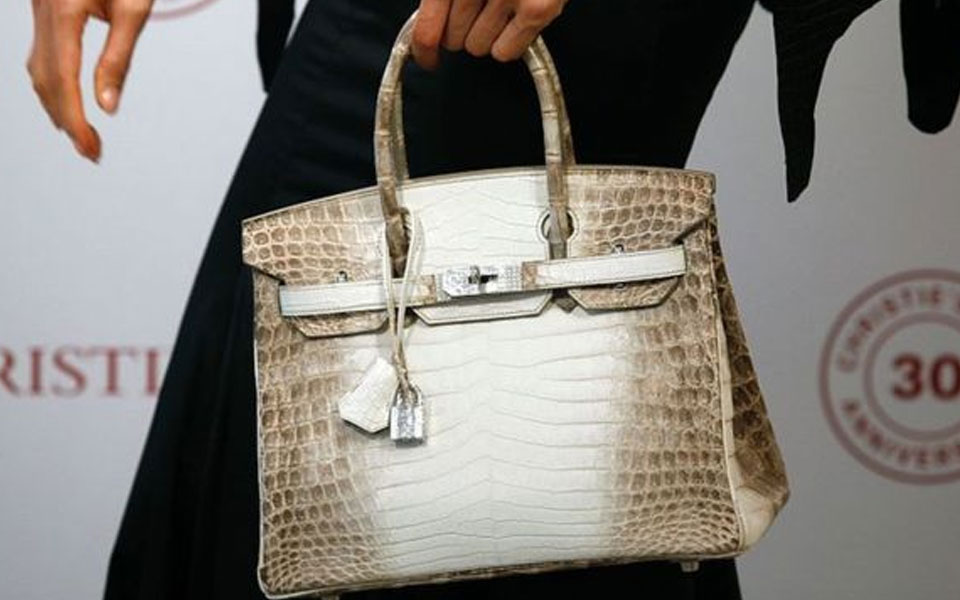London, June 13 : A 10-year-old second-hand Hermes Birkin bag has sold for $217,144 in London, a new European record for the most expensive handbag sold at an auction.
The 2008 Himalaya Birkin, with an 18-carat white gold diamond encrusted lock, exceeded its list price of 100,000-150,000 pounds on Tuesday, reports the BBC.
The record for a bag sold at auction - also a Hermes Birkin - is $380,000, set in Hong Kong in 2017. It is the "undisputed most valuable bag in the world", auction house Christie's said.
It was first time the bag had been offered in a European auction, said Matthew Rubinger, international director at the auctioneers. The niloticus crocodile bag was said to be in "grade 2 condition" with no obvious flaws.
It measures just 30 cm wide - smaller than the original Birkin handbag - and is made from nilo crocodile hide and features diamonds.
Its name refers to the colour gradient, said to resemble the snow-capped hills of the Himalayas. A 2006 blue version of the handbag sold for $133,608 at the same auction on Tuesday, the BBC reported.
New Birkin bags can start at around $9,350 each, but they are not easy to buy, with famously long waiting lists.
The French luxury fashion house Hermes designed what became known as the Birkin in 1981.
Named after the singer and actress Jane Birkin, it has become one of the most sought-after accessories in the world, but it began as a quest for the perfect holdall.
Let the Truth be known. If you read VB and like VB, please be a VB Supporter and Help us deliver the Truth to one and all.
Panaji (PTI): As part of a crackdown against tourist establishments violating laws and safety norms in the aftermath of the Arpora fire tragedy, Goa authorities on Saturday sealed a renowned club at Vagator and revoked the fire department NOC of another club.
Cafe CO2 Goa, located on a cliff overlooking the Arabian Sea at Vagator beach in North Goa, was sealed. The move came two days after Goya Club, also in Vagator, was shut down for alleged violations of rules.
Elsewhere, campaigning for local body polls, AAP leader Arvind Kejriwal said the fire incident at Birch by Romeo Lane nightclub at Arpora, which claimed 25 lives on December 6, happened because the BJP government in the state was corrupt.
An inspection of Cafe CO2 Goa by a state government-appointed team revealed that the establishment, with a seating capacity of 250, did not possess a no-objection certificate (NOC) of the Fire and Emergency Services Department. The club, which sits atop Ozrant Cliff, also did not have structural stability, the team found.
The Fire and Emergency Services on Saturday also revoked the NOC issued to Diaz Pool Club and Bar at Anjuna as the fire extinguishers installed in the establishment were found to be inadequate, said divisional fire officer Shripad Gawas.
A notice was issued to Nitin Wadhwa, the partner of the club, he said in the order.
Campaigning at Chimbel village near Panaji in support of his party's Zilla Panchayat election candidate, Aam Aadmi Party leader Kejriwal said the nightclub fire at Arpora happened because of the "corruption of the Pramod Sawant-led state government."
"Why this fire incident happened? I read in the newspapers that the nightclub had no occupancy certificate, no building licence, no excise licence, no construction licence or trade licence. The entire club was illegal but still it was going on," he said.
"How could it go on? Couldn't Pramod Sawant or anyone else see it? I was told that hafta (bribe) was being paid," the former Delhi chief minister said.
A person can not work without bribing officials in the coastal state, Kejriwal said, alleging that officers, MLAs and even ministers are accepting bribes.





